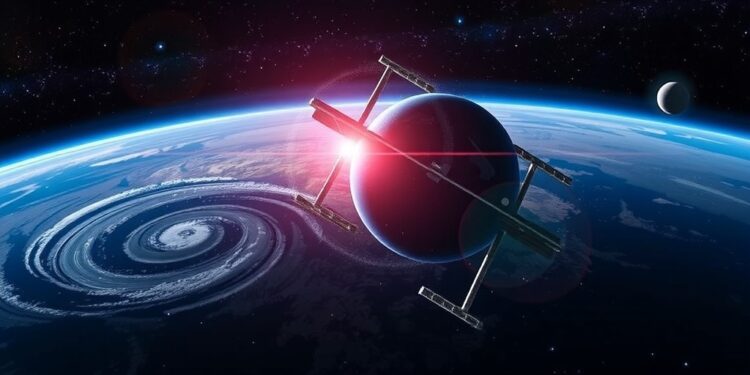As space continues to evolve into an arena where international security is increasingly at stake, the potential for conflict grows. The commercialization and militarization of outer space necessitate a robust legal framework that governs how nations can engage in military activities in this new frontier. A new and timely study by Chris O’Meara from the University of Exeter Law School explores how existing international law could serve as a foundational resource for mitigating the risks associated with the weaponization of space.
The backdrop of this research is the undeniable escalation in military tensions that have begun to manifest in space. Nations are investing heavily in anti-satellite (ASAT) weapons, devices engineered to incapacitate or destroy satellites. Such developments could provoke a new kind of arms race that extends beyond Earth, as countries strive to secure their interests in what has increasingly been viewed as a strategic domain. The implications of ASAT technologies stretch far and wide, impacting global communications, weather forecasting, and navigation systems, which are all fundamentally underpinned by satellite operations.
Space debris generated from the testing of ASAT weapons poses significant risks, threatening both civilian and military satellites. The environmental impact in space is alarming; collisions create debris fields that can persist for years, even decades, increasing the potential for unintended consequences and escalating tensions among nations. As such, regulating military activities and ensuring that the potential for armed conflict in space is curbed has never been more urgent.
The affirmations made in O’Meara’s study underscore the legal norms rooted in the UN Charter and customary international law. These laws can be pivotal when it comes to defining the limits on the use of force in space, especially in the context of self-defense. This legal framework does not just provide a guideline; it acts as a mechanism through which nations can conceptualize their military strategies and responses in ways that take into account the broader implications of their actions.
Understanding these existing legal constraints is vital for nations that depend on satellites for essential services, many of which have become integral to civilian life, such as telecommunications and banking. A legal and well-regulated approach to military activities in space offers not only protection for satellites but plays a crucial role in safeguarding international peace and security. Adhering to these legal principles aids in fostering an atmosphere of cooperation rather than confrontation—helping to mitigate fears of conflict in this uncharted territory.
Dr. O’Meara emphasizes the importance of a renewed discussion around established legal frameworks to address concerns about space militarization actively. With the knowledge that states are persistently enhancing their counterspace capabilities, clarifying legal obligations pertaining to acts of aggression in space becomes even more necessary. As states develop counter-satellite technologies, this legal grounding can help ensure that actions taken in self-defense remain proportionate, targeted, and justifiable under international law.
The ramifications of warfare in outer space extend beyond immediate military objectives. The potential for harming civilians and endangering state interests is profound both on Earth and in orbit. The interconnected nature of global systems implies that a conflict in space could lead to ripple effects that disrupt economies and harm societies worldwide. Hence, it is crucial that international dialogue focuses on legally binding constraints that can effectively govern state actions in outer space.
Moreover, as nations explore the commercialization of outer space, the balance between military and commercial interests becomes increasingly tenuous. Companies looking to leverage space-based assets must also heed the legal considerations that govern behavior in this domain. The interplay between state and non-state actors adds another layer of complexity to the laws governing space, necessitating a legal framework capable of adapting to changing dynamics.
As public reliance on satellite technology grows, so too does the urgency for global consensus on the rules governing their use. The international community must come together to establish concrete guidelines that not only protect space assets but also promote security and stability. This means addressing the ethical considerations of military engagement in space while working to prevent escalation into outright hostility.
Dr. O’Meara’s insights stress that all stakeholders benefit from a clearer understanding of legal restraints. As advancements in technology continue to shape our interactions in space, international law must evolve alongside it. Clarity in legal frameworks can mitigate the fear surrounding the weaponization of space, fostering more cooperation among states, especially as each nation strives to defend its satellite systems from potential threats.
The business of space is increasingly viewed through a dual lens of opportunity and risk, necessitating comprehensive legal oversight. The discussion around ASAT weapons illustrates the complexities that arise at the intersection of military preparedness and international law. States must navigate these complexities carefully, prioritizing legal obligations that can transcend national boundaries—ushering in an age of cooperative security rather than destructive rivalry.
In conclusion, the pressing questions surrounding the militarization of space cannot be ignored. The arguments presented in O’Meara’s study contribute significantly to the discourse on international law’s role in shaping behaviors in outer space. As countries grapple with the implications of their actions and seek to assert their rights in this new domain, understanding the legal landscape can pave the way for a more secure and stable future. Ultimately, fostering dialogue around these issues may foster the kind of international cooperation necessary for ensuring that space remains a domain of peace rather than conflict.
Subject of Research: People
Article Title: Self-defence in outer space: Anti-satellite weapons and the jus ad bellum
News Publication Date: 26-Mar-2025
Web References: DOI Link
References: None provided
Image Credits: None provided
Keywords: Space policy, International law, Weaponry, State law, Outer space, Warfare, Artificial satellites, Technology policy




